Southern spawn strategies
Gear up for second half heroics
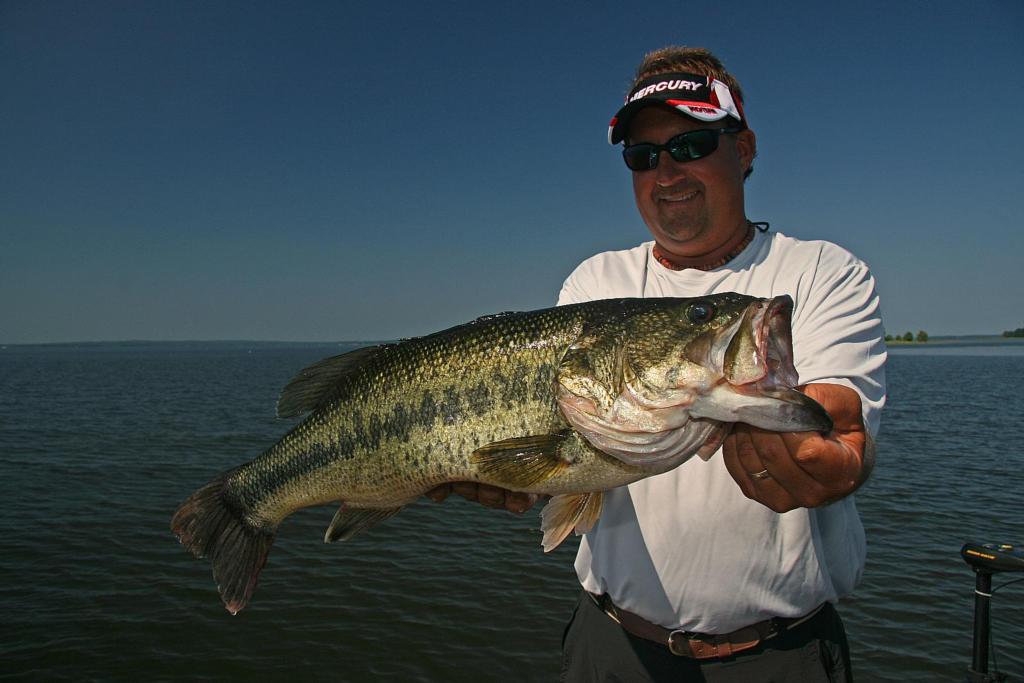
If we compared the southern spawning season to a football game, mid-March finds two quarters of play completed. But while the first part of the season has been stellar by most accounts, the second half of the spawn promises some highlight reel moments as well.
As evidenced by the record-smashing performances at the 2011 FLW Tour Open event on Lake Okeechobee, the southern spawn holds explosive potential. With Sunshine State waters remaining relatively warm just about year-round, Florida bass may spawn as early as January, with the year’s first full moon prompting the initial shoreward surge. Bob Wattendorf of the Florida Fish and Wildlife Conservation Commission’s Division of Freshwater Fisheries said that because bass tune into environmental triggers such as day length, lunar cycle and especially water temperature, timing of the actual spawn can vary.
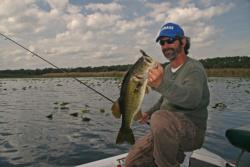 “Generally, once water temperatures rise above 58 degrees, the bedding process begins and may continue until temperatures are in the mid- to upper-70s,” Wattendorf said. “A couple of days before full or new moons in late February, March or early April are often premier spawning times for Florida bass. Remember, triggering water temperatures vary significantly based on depth, sun exposure and currents.”
“Generally, once water temperatures rise above 58 degrees, the bedding process begins and may continue until temperatures are in the mid- to upper-70s,” Wattendorf said. “A couple of days before full or new moons in late February, March or early April are often premier spawning times for Florida bass. Remember, triggering water temperatures vary significantly based on depth, sun exposure and currents.”
Of course, that schedule starts and runs a little later in the south’s upper latitudes, but throughout his southern Texas-Louisiana range, FLW pro Stephen Johnston finds his bass on roughly the same timeline by March. Johnston says most lakes in this region are about halfway through the spawn by the big moon of March (this year, the 19th), but that bright lunar phase, along with April’s can offer some of the season’s top action.
“There’s always a wave of fish on all of our lakes that wait for that April moon,” Johnston said. “The last stragglers will be a pretty good wave and they’re a lot more aggressive. The water has warmed up and they’ve been in the warm water longer.
“Anytime a bait gets close to the beds, the bass are a lot easier to catch. I think those fish are more accustomed to the warm water. They’re eager to get the eggs out of them and get back to eating, so anything that gets close to the beds will get hammered.”
Search party
Whether it’s a placid bay strewn with reeds and scattered lily pads, or a broad flat with a prominent grass line, finding bed fish takes some looking. The problem here, though, is that if you can see the fish, they’ve already seen you and that fine line of tolerance can vaporize in a twinkling. Stealth is critical and distance is your best strategy.
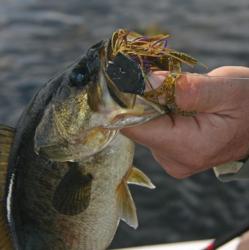 Florida pro Mike Faust searches broad areas and then drills down to focus on active spots. It takes a lot of casting to break down the water so he likes baits that do most of the work for him. A Reaction Innovations Skinny Dipper rigged weightless on a Daiichi Hitchhiker presents an irresistible display when retrieved across the surface. Same deal with a Strike King Rage Toad – those paddling legs kick up a bass-tempting wake. Faust will also use ChatterBaits for his search missions.
Florida pro Mike Faust searches broad areas and then drills down to focus on active spots. It takes a lot of casting to break down the water so he likes baits that do most of the work for him. A Reaction Innovations Skinny Dipper rigged weightless on a Daiichi Hitchhiker presents an irresistible display when retrieved across the surface. Same deal with a Strike King Rage Toad – those paddling legs kick up a bass-tempting wake. Faust will also use ChatterBaits for his search missions.
“I try to cover a lot water with fast-moving baits just to find some fish, then I narrow it down to what I call the `red zone’,” he said. “That’s the area with the largest concentration of fish. You get in there and just pick it apart. I’ll go to a slower moving bait like a Senko or a tube worm and just keep working it.”
Faust often does his searching with spinning gear, which allows him the longer casts needed to probe broad areas and pinpoint the hot spots. As he notes, braided or fluorocarbon line is the way to go with spinning gear, as they banish the long-distance limitation of stretchy monofilament.
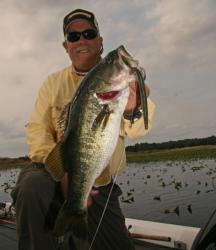 “Making a long cast is imperative (when searching for spawning bass), because you’re in shallow water and a lot of times you’re in clear water so you don’t want to spook the fish,” Faust said. “With these (braided and fluorocarbon) lines, you’re able to make long casts and get a hook in the fish, whereas you wouldn’t be able to with monofilament because it has too much stretch.”
“Making a long cast is imperative (when searching for spawning bass), because you’re in shallow water and a lot of times you’re in clear water so you don’t want to spook the fish,” Faust said. “With these (braided and fluorocarbon) lines, you’re able to make long casts and get a hook in the fish, whereas you wouldn’t be able to with monofilament because it has too much stretch.”
The distant strategy served Brandon Medlock well in January, as he claimed the EverStart Series win on Lake Okeechobee. Fishing isolated clumps of pencil reeds, Kissimmee grass and cattails; he stayed 30-50 feet away from his targets and used a 1-ounce jig with double weed guards to probe the shallows for big fish.
When Kelly Owens won the EverStart Texas Division event on Choke Canyon Lake in late January, he dialed in a great little spot where he intercepted fish heading to the beds. While others searched shoreline grass for fish ready to move up, Owens committed three days to a small drain that was perfectly suited for prespawn staging. Positioning within casting range of the fish’s travel lane, he kept cranking the drop-offs until he located big bass entering the maternity ward.
Residential shorelines also see plenty of spawning activity, especially wide sandy stretches between docks. And don’t forget to look way back under those docks, as these sheltered spots can hold some of the biggest bed fish.
Find `em and annoy `em
Home invasion – that’s the concept behind baits used to taunt bedding bass. For example, flip a Texas-rigged tube into a bass bed and those wiggling tentacles will red line the fish’s fury.
Sometimes, a simple bold display is all it takes. The Kicker Fish Hightail Ribbontail worm is made with small air-trapping holes that hold the bait upright for a tantalizing wiggle. Similarly, FLW pro Tommy Hagler makes the Hag’s Tornado – a hybrid stick worm, ring worm and floating worm with a limber body that drives bed fish nuts.
“The (Tornado) has (hollow tail) so it stands up straight in the bed – those bass can’t stand that,” said Kellogg’s Rice Krispies pro and Tornado fan, Jim Tutt of Longview, Texas.
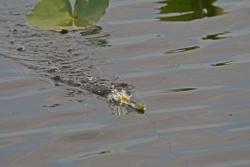 Texas-rigged creature baits like the Berkley Power Hawg, Zoom Baby Brush Hog and the Attraxx Jacobug (designed by FLW Duracell/Gillette pro Jacob Powroznik) get lots of bed play, as their obnoxious forms and wiggling appendages take irritation to a new level. Johnston likes a Gene Larew craw worm rigged on a 5/0 extra wide gap Gamakatsu hook and a ¼- to 3/8-ounce tungsten bullet weight. He might drop down to a 3/0 hook if he’s finding smaller bass, but he’s more inclined to keep plenty of steel in his hook, as this helps him nab the fish at close range.
Texas-rigged creature baits like the Berkley Power Hawg, Zoom Baby Brush Hog and the Attraxx Jacobug (designed by FLW Duracell/Gillette pro Jacob Powroznik) get lots of bed play, as their obnoxious forms and wiggling appendages take irritation to a new level. Johnston likes a Gene Larew craw worm rigged on a 5/0 extra wide gap Gamakatsu hook and a ¼- to 3/8-ounce tungsten bullet weight. He might drop down to a 3/0 hook if he’s finding smaller bass, but he’s more inclined to keep plenty of steel in his hook, as this helps him nab the fish at close range.
“A little overkill on the hook doesn’t hurt anything,” Johnston said. “If you use a hook that’s too small, when you jerk with that short line, a big fish will straighten that hook out.”
With most bed-fishing baits, a ticked off bass will attack just about any color in the spectrum, however, white offers anglers a distinct advantage.
“The reason we use that white (bait) is that you can see the bait,” Johnston said. “The fish can be finicky and they might pick at one pincer, pick at another and finally get aggravated enough to eat the bait. The color really doesn’t matter to the fish because they’re just in a stand-off with anything that comes near their nest. I use a white bait so I can see the bait when it disappears.”
Johnston also likes the Lateral Perch – a unique swimbait/jig hybrid created by fellow FLW Texas pro Tim Reneau. Introduced in 2010, the Lateral Perch features a weighted head with a stout hook and a weed guard protruding from the side of a panfish body. With the heavy head pulling it to the bottom, the bait’s lateral orientation gives it a tantalizing fall with a strategic presentation.
Favoring the ¾- or 1-ounce models, Johnston said: “You can get down there and shake that dust up and it looks like a bluegill pecking around at those eggs. From a fish’s perspective, it looks like a bluegill lying on its side with the eye looking back at the bass and that’s intimidating. I think that aggravates a bass a lot quicker than baits that don’t have (prominent) eyes.”
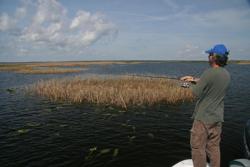 Bedding bass also despise intruders looking down from above and that’s why hollow body frogs like the Spro Bronzeye, Tru-Tungsten Madd Max and the Snagproof Ish’s PHAT Frog prove so effective for searching, as well as for targeted presentations. Unlike buzz toads that sink when paused, a frog holds its position over a nest and bass don’t take kindly to peeping Toms.
Bedding bass also despise intruders looking down from above and that’s why hollow body frogs like the Spro Bronzeye, Tru-Tungsten Madd Max and the Snagproof Ish’s PHAT Frog prove so effective for searching, as well as for targeted presentations. Unlike buzz toads that sink when paused, a frog holds its position over a nest and bass don’t take kindly to peeping Toms.
Bucking traditional wisdom of subtlety, some anglers taunt bedding bass with an aggressive game intended to quickly identify the impact players. Like the Bears’ William “The Refrigerator” Perry rumbling in for touchdown, running a hefty swimbait through the bedding zone can deliver big results. It’s not for everyone and not every bass will follow the script. Some fish will just spook at the oversized presence, but the ones that stand a fight are the ones you want anyway.
Whatever you throw at southern spawners, remember the politics of proximity. Always give bed fish a respectable berth and take caution not to spook them with abrupt changes in trolling motor speed or the boat’s pressure wake.
Invaluable to this objective is a shallow water anchor mechanism like the PowerPole or Minn Kota Talon. The ability to instantly stake out the boat enables you to silently work a stretch of shoreline in measured steps without the risk of drifting over your fish. When needs/opportunities arise, use the anchoring shafts like arms to reach across lay-down branches, dock cables, etc., and hold your position for extended presentations.
Moreover, you can angle your boat to block wind and improve visibility on the leeward surface. Just remember that visibility works both ways, so keep your distance and minimize the movements.